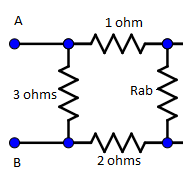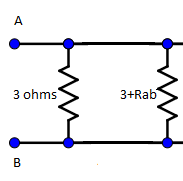Answer
64.8k+ views
Hint By using the resistor in series and resistor in parallel formula, the solution can be determined. Before that one assumption must be made. This circuit goes to an infinity, so that we consider the one loop for our calculation. In the end the result is in equation form, then by using the quadratic equation formula, the solution can be determined.
Useful formula
The resistor in series formula is given by,
$R = {R_1} + {R_2} + ...........$
Where, $R$ is the total resistance of the resistor in series and ${R_1}$, ${R_2}$ are the resistance of the individual resistor.
The resistor in parallel formula is given by,
$\dfrac{1}{R} = \dfrac{1}{{{R_1}}} + \dfrac{1}{{{R_2}}} + ...........$
Where, $\dfrac{1}{R}$ is the total resistance of the resistor in parallel and ${R_1}$, ${R_2}$ are the resistance of the individual resistor.
Complete step by step solution
The above given diagram is having same loop but it goes infinitely, so we take only the first loop, so that the first loop contains four resistors.

From the above diagram the three resistors are in series, $1\,\Omega $, $2\,\Omega $ and ${R_{AB}}$ are in series, then by using the resistor in series formula, then
$R = 1 + 2 + {R_{AB}}$
By adding the terms in the above equation, then
$R = 3 + {R_{AB}}$
Now, the circuit will be come two resistors and these two resistors are in parallel,

From the above diagram the two resistors are in parallel, so by using the resistors in parallel formula, then
$\dfrac{1}{{{R_{AB}}}} = \dfrac{1}{3} + \dfrac{1}{{\left( {3 + {R_{AB}}} \right)}}$
By cross multiplying the terms in the above equation, then
$\dfrac{1}{{{R_{AB}}}} = \dfrac{{3 + {R_{AB}} + 3}}{{3\left( {3 + {R_{AB}}} \right)}}$
On further simplification in the above equation, then
$\dfrac{1}{{{R_{AB}}}} = \dfrac{{{R_{AB}} + 6}}{{9 + 3{R_{AB}}}}$
By cross multiplying the terms in the above equation, then
$9 + 3{R_{AB}} = {R_{AB}}\left( {{R_{AB}} + 6} \right)$
On multiplying the terms in the above equation, then
$9 + 3{R_{AB}} = {R_{AB}}^2 + 6{R_{AB}}$
By rearranging the terms in the above equation, then
${R_{AB}}^2 + 3{R_{AB}} - 9 = 0$
This equation is in the form of a quadratic equation.
From the above equation, the values of $a = 1$, $b = 3$ and $c = - 9$, these values are the coefficient of equations.
The formula to solve the quadratic equation is, ${R_{AB}} = \dfrac{{ - b \pm \sqrt {{b^2} - 4ac} }}{{2a}}$
Now substituting the values of $a$, $b$ and $c$ in the above equation, then
${R_{AB}} = \dfrac{{ - 3 \pm \sqrt {{3^2} - \left( {4 \times 1 \times - 9} \right)} }}{{2 \times 1}}$
On multiplying the terms in the above equation, then
${R_{AB}} = \dfrac{{ - 3 \pm \sqrt {9 + 36} }}{{2 \times 1}}$
On adding the terms in the above equation, then
${R_{AB}} = \dfrac{{ - 3 \pm \sqrt {45} }}{{2 \times 1}}$
The above equation is also written as,
${R_{AB}} = \dfrac{{ - 3 \pm \sqrt {9 \times 5} }}{{2 \times 1}}$
By taking the square root in the above equation, then
${R_{AB}} = \dfrac{{ - 3 \pm 3\sqrt 5 }}{2}$
By taking the common terms in the above equation, then
\[{R_{AB}} = \dfrac{3}{2}\left( { - 1 \pm \sqrt 5 } \right)\]
Then the above equation is written as,
\[{R_{AB}} = \dfrac{3}{2}\left( {\sqrt 5 - 1} \right)\,\Omega \]
Hence, the option (A) is the correct answer.
Note The circuits given in the question are infinite loop so that we take one loop in the given circuit and the calculations are made. By using the resistor in series and resistors in parallel formula, just check the registers that are in series are parallel thoroughly.
Useful formula
The resistor in series formula is given by,
$R = {R_1} + {R_2} + ...........$
Where, $R$ is the total resistance of the resistor in series and ${R_1}$, ${R_2}$ are the resistance of the individual resistor.
The resistor in parallel formula is given by,
$\dfrac{1}{R} = \dfrac{1}{{{R_1}}} + \dfrac{1}{{{R_2}}} + ...........$
Where, $\dfrac{1}{R}$ is the total resistance of the resistor in parallel and ${R_1}$, ${R_2}$ are the resistance of the individual resistor.
Complete step by step solution
The above given diagram is having same loop but it goes infinitely, so we take only the first loop, so that the first loop contains four resistors.

From the above diagram the three resistors are in series, $1\,\Omega $, $2\,\Omega $ and ${R_{AB}}$ are in series, then by using the resistor in series formula, then
$R = 1 + 2 + {R_{AB}}$
By adding the terms in the above equation, then
$R = 3 + {R_{AB}}$
Now, the circuit will be come two resistors and these two resistors are in parallel,

From the above diagram the two resistors are in parallel, so by using the resistors in parallel formula, then
$\dfrac{1}{{{R_{AB}}}} = \dfrac{1}{3} + \dfrac{1}{{\left( {3 + {R_{AB}}} \right)}}$
By cross multiplying the terms in the above equation, then
$\dfrac{1}{{{R_{AB}}}} = \dfrac{{3 + {R_{AB}} + 3}}{{3\left( {3 + {R_{AB}}} \right)}}$
On further simplification in the above equation, then
$\dfrac{1}{{{R_{AB}}}} = \dfrac{{{R_{AB}} + 6}}{{9 + 3{R_{AB}}}}$
By cross multiplying the terms in the above equation, then
$9 + 3{R_{AB}} = {R_{AB}}\left( {{R_{AB}} + 6} \right)$
On multiplying the terms in the above equation, then
$9 + 3{R_{AB}} = {R_{AB}}^2 + 6{R_{AB}}$
By rearranging the terms in the above equation, then
${R_{AB}}^2 + 3{R_{AB}} - 9 = 0$
This equation is in the form of a quadratic equation.
From the above equation, the values of $a = 1$, $b = 3$ and $c = - 9$, these values are the coefficient of equations.
The formula to solve the quadratic equation is, ${R_{AB}} = \dfrac{{ - b \pm \sqrt {{b^2} - 4ac} }}{{2a}}$
Now substituting the values of $a$, $b$ and $c$ in the above equation, then
${R_{AB}} = \dfrac{{ - 3 \pm \sqrt {{3^2} - \left( {4 \times 1 \times - 9} \right)} }}{{2 \times 1}}$
On multiplying the terms in the above equation, then
${R_{AB}} = \dfrac{{ - 3 \pm \sqrt {9 + 36} }}{{2 \times 1}}$
On adding the terms in the above equation, then
${R_{AB}} = \dfrac{{ - 3 \pm \sqrt {45} }}{{2 \times 1}}$
The above equation is also written as,
${R_{AB}} = \dfrac{{ - 3 \pm \sqrt {9 \times 5} }}{{2 \times 1}}$
By taking the square root in the above equation, then
${R_{AB}} = \dfrac{{ - 3 \pm 3\sqrt 5 }}{2}$
By taking the common terms in the above equation, then
\[{R_{AB}} = \dfrac{3}{2}\left( { - 1 \pm \sqrt 5 } \right)\]
Then the above equation is written as,
\[{R_{AB}} = \dfrac{3}{2}\left( {\sqrt 5 - 1} \right)\,\Omega \]
Hence, the option (A) is the correct answer.
Note The circuits given in the question are infinite loop so that we take one loop in the given circuit and the calculations are made. By using the resistor in series and resistors in parallel formula, just check the registers that are in series are parallel thoroughly.
Recently Updated Pages
Write a composition in approximately 450 500 words class 10 english JEE_Main

Arrange the sentences P Q R between S1 and S5 such class 10 english JEE_Main

What is the common property of the oxides CONO and class 10 chemistry JEE_Main

What happens when dilute hydrochloric acid is added class 10 chemistry JEE_Main

If four points A63B 35C4 2 and Dx3x are given in such class 10 maths JEE_Main

The area of square inscribed in a circle of diameter class 10 maths JEE_Main

Other Pages
A boat takes 2 hours to go 8 km and come back to a class 11 physics JEE_Main

Electric field due to uniformly charged sphere class 12 physics JEE_Main

In the ground state an element has 13 electrons in class 11 chemistry JEE_Main

According to classical free electron theory A There class 11 physics JEE_Main

Differentiate between homogeneous and heterogeneous class 12 chemistry JEE_Main

Excluding stoppages the speed of a bus is 54 kmph and class 11 maths JEE_Main




